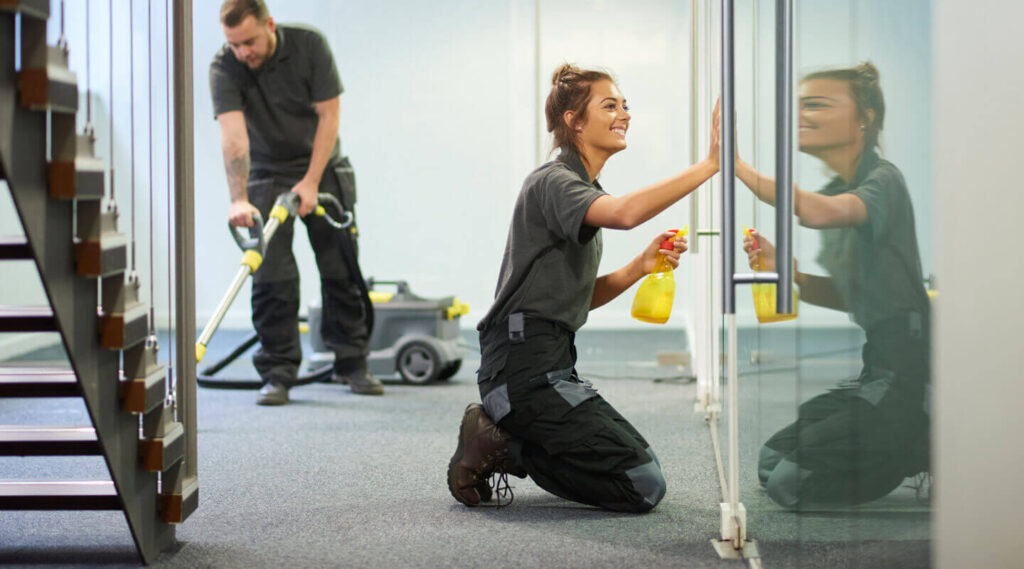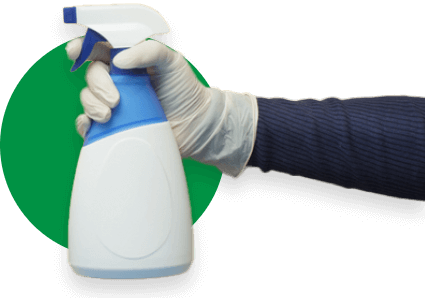Did you know that an average of 95 million workdays are lost each year due to slip-and-fall accidents within the workplace? These accidents are usually preventable and make a big impact on overall productivity. Often hidden heroes of the workplace, a highly qualified janitorial team can make a significant impact on waste management, inventory management, safety, and workplace hygiene.
Individuals working in a warehouse setting depend on having a safe and clean environment in order to thrive. Consistent warehouse disinfection is a great way to support the health of businesses and their workers.
The purpose of warehouse disinfection is to eliminate potentially harmful bacteria and viruses. Warehouse cleaning is done by trained professionals. Warehouse disinfectant is made of special chemicals registered by the EPA designed to sanitize the workspace and kill unwanted germs. Warehouse disinfection is commonplace and strongly encouraged for all businesses.
The purpose of this article is to educate the reader on warehouse cleaning. It will show you how to disinfect warehouse spaces like a pro so you can avoid injuries and illnesses in the workplace.

Warehouse Disinfection Checklist
Organization is a crucial part of maintaining a clean and safe warehouse. Having separate daily, weekly, and monthly warehouse disinfection checklists is a great way to keep operations moving smoothly.
Some examples of disinfectant warehouse solutions include cleaning equipment, wiping down countertops, cleaning surfaces often used by workers, using warehouse floor cleaners, vacuuming, and more.
Daily: Warehouse Disinfection
This checklist is meant for warehouse cleaning, which should be regarded as necessary each day. Failing to do so may result in avoidable illness and injury.
- Clean and sanitize surfaces that are used each day, such as door handles, light switches, and shelves
- Cleaning warehouse equipment such as pallets
- Use warehouse disinfectant to wipe down countertops
- Vacuum or sweep floors
- Clean trolleys, trolley hands, grab bars, and keys
- Mop the floors with warehouse floor cleaner or a steam mop
- Get rid of waste and garbage
- Disinfect warehouse bathrooms
- Make sure tissues, soap, and toilet paper is refilled
- Cleaning warehouse toilets with warehouse disinfectant
- Clean sinks and countertops in the bathroom
Weekly: Warehouse Disinfection
Weekly warehouse disinfection is not needed as often but is just as crucial to the warehouse cleaning process. Some examples of weekly disinfectant warehouse solutions include:
- Cleaning and making sure equipment and machinery are properly maintained
- Disinfect warehouse windows and curtains
- Dusting high ceilings, door frames, grab bars, light fixtures, wall partitions, and shelves
- When necessary, reorganize pallets and shelves
- Polish all glass fixtures, including windows, doors, walls, and wall partitions
- Restock and check necessary supplies
Monthly: Warehouse Disinfection
While monthly warehouse disinfection may be more infrequent than the previous lists, that can be considered just as, if not more, important. These disinfectant warehouse solutions are more focused on deep cleaning in order to avoid potentially hazardous conditions over time.
- Scrubbing walls thoroughly
- Cleaning walkways and pathways of dirt, dust, snow, and other potentially hazardous materials
- Explore the space, including drains and sinks, for potential signs of mildew and mold
- Using warehouse floor cleaner to deep clean floors
- Steam clean hard surface floors and shampoo the carpets
- Explore the space for potential pests such as mice and rats
- Change upholstery covers if relevant
- Use a hose or power washer for cleaning the warehouse exterior
- Deep clean loading docks, steps, and entry docks
Warehouse Disinfection Process
The warehouse disinfection process takes attentive planning and care. The more thorough you prepare, the quicker and easier the warehouse disinfection process will be. Having a systematic process is crucial to completing daily, weekly, and monthly checklists, as well as maintaining a safe and clean workspace.
The five steps for the warehouse disinfection process include:
- The Prep Work: This is the planning stage of the process. Have your checklists organized, have clear goals for the day, and have all the cleaning supplies stocked and ready to go. If you have a team working alongside you, be sure they have also been properly prepped. Ensure they also know who to report to if there are any issues.
- Preliminary Cleaning: This type of warehouse cleaning is to eliminate obvious surface debris. This may include much of what was reported in the daily checklist above (cleaning surfaces that appear dirty such as doorknobs, equipment, countertops, and more). Additionally, this may include the use of warehouse disinfectant cleaning supplies, brooms, and more.
- Cleaning High Areas: When it comes to warehouse disinfection, it’s essential not to neglect anything. Doing so may cause problems later on. Be sure to include high areas such as ceilings, high walls, and light fixtures. Dust, dirt, debris, and even mold can build up without attention.
- Sanitize, Disinfect, and Properly Clean Floors: Many accidents occur due to wet or poorly maintained floors. Floors must be maintained on a daily, weekly, and monthly basis. Using warehouse floor cleaners, polishing, sweeping, mopping, and vacuuming are all part of the process. This includes the warehouse floor and bathrooms.
- Reviewing Your Checklists: Sticking to disinfectant warehouse checklists will ensure that your space is clean and safe. Once you feel you have completed it, go back and double-check, just in case. This is a great way to leave the warehouse knowing there won’t be any surprises the next day.
Common Challenges Faced in Maintaining Warehouse Cleanliness
While sticking to your warehouse disinfection sounds simple enough, your workspace may not always cooperate with your intentions. When trying to disinfect warehouse spaces, challenges may come and make the process more difficult. Each space has its own unique set of challenges.
Here are some examples of difficulties that can occur in the warehouse disinfection process.
- The space is very big and spacious. Some warehouses can be more than 20,000 square feet, usually jam-packed with various forms of equipment. This can make a job timely and strenuous. That’s why planning and checklists are so valuable. The last thing you need is disorganization during a big job.
- Operation and production disruptions can occur. Just like a cleaning or janitorial team, warehouse workers also have a schedule. When your schedule clashes with theirs, it can become difficult to get your job done. This is where good communication is key. Being clear and precise in your communication can help you avoid such a conflict.
- When equipment isn’t properly maintained. If a warehouse team isn’t caring for their equipment properly, it can lead to issues with cleanliness. Dirt, debris, and dust can build up quickly, which can ultimately affect many aspects of the workspace. Regularly providing warehouse disinfection can make a major impact on productivity over time.
The Do’s and Don’ts Of Warehouse Cleaning
On the surface, warehouse cleaning might seem simple. Unfortunately, many people find out the hard way that it can be time-consuming, hazardous, and tedious if not done correctly. Here are some of the dos and don’ts of warehouse cleaning:
- Make sure you have a plan. As mentioned in previous sections, having a plan can save you a lot of time and stress. When cleaning your home, you might be able to get away with winging it. When it comes to cleaning large, industrialized spaces, preparation could potentially cut your work in half. This includes cleaning checklists, cleaning strategies/solutions, and collecting supplies.
- Put together a cleaning schedule. As part of your preparation, create a schedule in order to keep you balanced and focused on the tasks at hand. Give these tasks a realistic timetable so you can best organize your day. A cleaning schedule is also crucial due to the operational business you are interrupting within the warehouse. If your schedule clashes with theirs, it will be difficult to get your job completed.
- Don’t allow the garbage bins to build up. A great way to keep harmful bacteria out of a space is to take out the garbage regularly. As we all know, when garbage piles up, it can make a space smelly and unpleasant. Be attentive to the trash and toss it out at least once a day.
- Don’t let inventory products get dirty and dusty. It’s easy to neglect inventory that’s sitting in the back of a warehouse. However, when it comes down to it, inventory is incredibly important to that business. Be sure to regularly check up on these products and make sure they are clean and properly maintained.

Why Use Professional Warehouse Cleaning Services?
Maintaining a clean and safe warehouse is critical to a properly functioning business. When warehouse disinfection is prioritized, the job of your workers can run smoothly and effectively.
That’s why having a highly qualified professional warehouse cleaning service like Dallas Janitorial Services can make all the difference in the world. When waste management, inventory management, safety, and workplace hygiene are taken care of, warehouse workers miss less time due to injury and illness. Not to mention, they become more productive.
Don’t wait until an accident occurs to get the help you need. Explore Dallas Janitorial Services disinfecting services today.
Frequently Asked Questions
How often should the warehouse be disinfected?
This depends on your specific business. However, it is recommended to receive a warehouse disinfection every few months or even monthly. This ensures that your workers are safe and able to perform their tasks efficiently.
Why do we clean the warehouse?
Maintaining a clean and organized warehouse saves time, eliminates waste, keeps workers safe, and efficiently manages inventory.
How do you clean a warehouse floor?
Warehouse floors require an industrial-strength vacuum with strong suction to pick up dirt, debris, and dust. Mopping can also be helpful.
What is the difference between sanitizing and disinfecting a warehouse?
Sanitizing is designed to eliminate bacteria on surfaces but doesn’t eliminate viruses. Disinfecting is done to kill both bacteria and viruses. Both words are often used interchangeably and use specific chemicals.
Why Does a Clean Warehouse Help Businesses Thrive?
Warehouse disinfection improves workplace productivity by assisting with waste management, inventory management, safety, workplace hygiene, and more. When warehouses are properly maintained, there are fewer accidents and illnesses in the workplace.
When disinfecting a warehouse space, it is important to use daily, weekly, and monthly checklists in order to optimize cleanliness. Organization and communication are vital to creating a safe and clean warehouse.
Having an experienced and highly qualified janitorial team at your disposal is a crucial resource for all businesses. Dallas Janitorial Services is ready to help! Explore our disinfecting services and contact us today.


